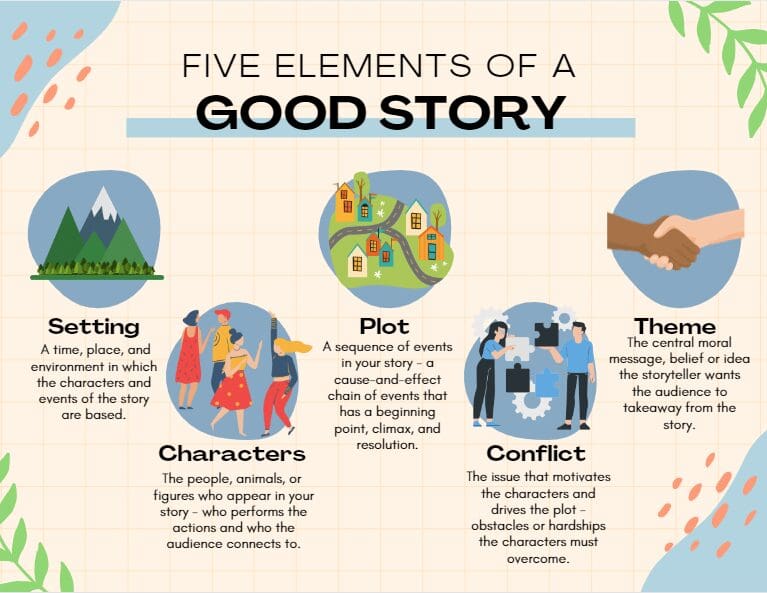
Creating Narratives Using Storyboards
Storytelling Basics
Storytelling is an art that, when mastered, can have huge impacts on how audiences receive and retain information. Storytelling is different from simply sharing facts and information because the aim of a good story is to build intellectual and values-based connections with your audience, to appeal to their emotions and their humanity.
“Good stories appeal to our collective humanity, tap into our emotions, create a connection and can keep the listener engaged as they become invested in the outcome.”
Developing a good story takes practice, but generally good stories involve these 5 elements, that all need to be considered when you are developing your story:

- Setting: A time, place, and environment in which the characters and events of the story are based.
- Characters: The people, animals, or figures who appear in your story – who performs the actions and who the audience connects to.
- Plot: A sequence of events in your story – a cause-and-effect chain of events that has a beginning point, climax, and resolution.
- Conflict: The issue that motivates the characters and drives the plot – obstacles or hardships the characters must overcome.
- Theme: The central moral message, belief or idea the storyteller wants the audience to take away from the story.
In addition to these five elements, storytelling is most effective when visual aids, imagery, descriptive language, and rhetorical devices are used:
- Visuals aids: Images can convey a lot of information – be intentional about which images and videos you display along with your narrative
- Imagery: Visual or written descriptions of what the setting and characters look like can help audience connect to the narrative more
- Descriptive Language: Appeal to the 5 senses to help your audience feel like they are transported into the story
- Rhetorical Devices: Language tools that help relate your story to be relatable and interesting – List of Effective Rhetorical Devices
Developing your story using storyboards
Stories come in many formats: we consume stories when we are talking to friends, watching videos, reading books and articles. When considering telling stories in more visual formats, using images, videos, illustrations and graphics, there are tools you can use to imagine your story’s visual elements.
A storyboard is a visual representation of your story that is often used in filmmaking, animation, and comics. It consists of a series of illustrations or images, paired with descriptive story text, arranged in sequence to outline the key events and scenes of your narrative. Why use storyboards?
- Visualize Ideas: Storyboards help you imagine your story elements before committing it to its final form.
- Plan Ahead: They allow you to plan the structure, pacing, and composition of your narrative.
- Communicate your Ideas: Storyboards serve as a communication tool to share your vision with others so they can picture what you’re envisioning.
Where to Start:
To get started, you can use a variety of formats and platforms to get your storyboard underway. This template is a basic example of a storyboard and a great place to start:
Tips for creating your storyboard:
- Identify your 5 story elements: Start by outlining the key elements of your narrative, including characters, setting, plot, conflict and theme.
- Break your story down into scenes: Divide your story into key scenes or moments. Each scene should represent a significant development in the narrative.
- Create images for each scene: Collect images, draw simple sketches or develop AI imagery for each scene. Focus on capturing the essential elements such as characters, actions, and important visual details.
- Add story text with details: Include descriptive and essential story text beneath each scene image to describe the action, dialogue, setting, and any other relevant information for each scene.
- Arrange your scene sequentially: Organize your scenes in sequential order to represent the flow of your story. You can use the provided storyboard template or create your own layout.
Review and assess story flow: Step back and review your storyboard as a whole. Make revisions as needed to improve flow, narrative coherence, and that your ideas are clearly represented.



